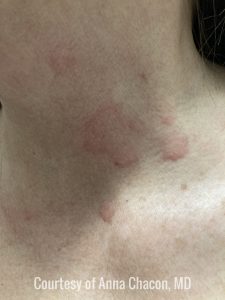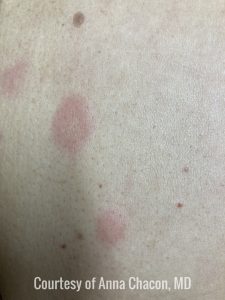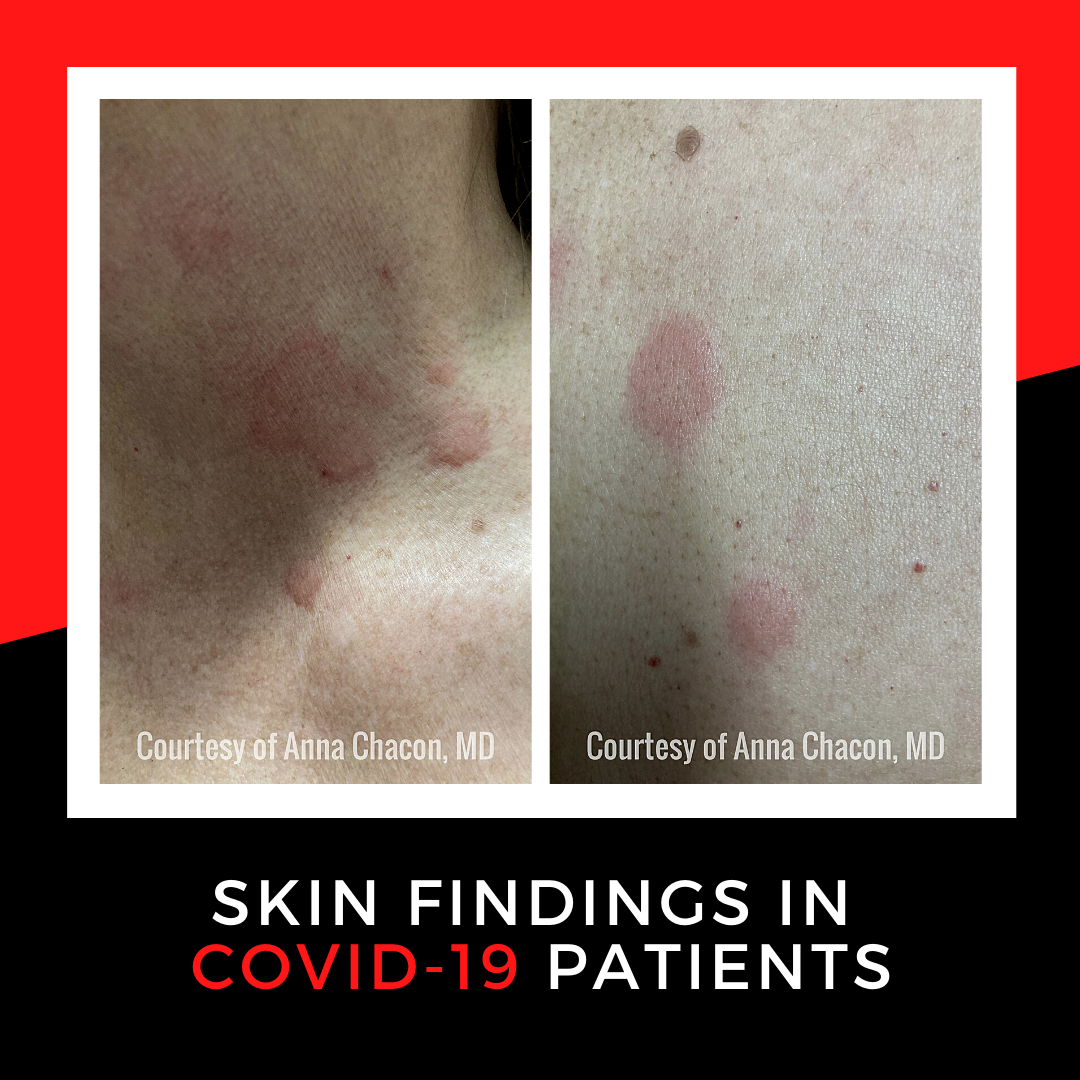The skin findings in COVID-19 patients include a morbilliform rash, urticaria, vesicular eruptions, acral lesions (COVID toes), livedoid eruptions, and other nonspecific skin findings.
Skin findings of COVID-19 disease are similar to the cutaneous findings in other viral infections. Some of the skin findings are more commonly associated with COVID-19 infection than with other viruses suggesting that they could possibly be the presenting finding of the illness. As cases of COVID-19 infection continue, we are beginning to understand the dermatologic manifestations of this systemic coronavirus, and how it affects each organ in the body, including the largest organ – skin. In addition, sometimes these skin findings have diagnostic or prognostic value. In this piece, I plan to explore some of the skin manifestations in patients diagnosed with COVID-19.
Morbilliform rashes are common in viruses and are sometimes seen in coronavirus. For instance, in a patient cohort in Italy, approximately 77% of patients with COVID-19 who developed skin findings presented with a morbilliform rash¹. Several investigations from Spain also reported this development, and in one case reported purpuric-like lesions.
Urticaria is a potential manifestation of coronavirus. In the Italian study described above, several patients developed widespread urticaria (3 out of 18). Doctors in Spain reported a 32-year-old patient with an itchy urticarial eruption that occurred after starting treatment with azithromycin and hydroxychloroquine and responded to antihistamines². Similarly, a patient in France developed urticaria, arthralgias, and painful swallowing 48 hours before she developed fever, chills, and ultimately a COVID-19 diagnosis³. The timing of urticarial lesions present prior to the development of other symptoms supports skin eruptions as a possible presentation of COVID-19.
Vesicular eruptions that resemble varicella and other viral lesions represent a large cohort of patients. Most skin manifestations last 8 days while the onset from the beginning of symptoms after the rash was 3 days. There is no association of disease severity with skin findings. A biopsy shows similar histological features that can be observed in other viral exanthemas such as interface dermatitis with apoptotic keratinocytes.
Acral lesions (COVID toes) have been reported in patients with coronavirus as perniosis-like acral lesions in addition to pruritic erythematous papules on the heels in several case reports. Acral lesions in coronavirus may take many different forms of presentation.
There have been several cases reported of livedoid eruptions in these patients presenting with lesions that look like livedo reticularis. These changes may be unilateral and asymmetry and are thought to be due to thrombotic vasculopathy induced y the virus. In particular, these lesions may actually have prognostic value if they are recognized in patients with systemic thrombotic vasculopathy. Some of these patients required supplemental oxygen during their course of hospitalization.
Other rare findings in patients with coronavirus include SDRIFE (symmetrical drug-related intertriginous and flexural exanthem) as well as a petechial eruption that resembled the skin rash observed in Dengue fever.
Personal Experience at Cleveland Clinic Florida
While much of South Florida had become the epicenter of the coronavirus pandemic, rarely were skin eruptions seen in these patients and when they did present, it was difficult to isolate a particular morphology as various skin abnormalities were present simultaneously.
At Cleveland Clinic, we have observed various skin findings that have aligned with the morphologies described above. The same patient may also present with different morphologies.


In conclusion, we still have a lot to learn about the skin findings in coronavirus – sometimes it appears that there are more questions than answers. It is unclear how many infected patients end up developing skin manifestations. There is great variability within the cohorts of how many patients actually end up developing COVID-19 infection – the percentage ranges from 20% in some studies to 1.8% in others. In addition, many patients end up very sick requiring many systemic medications to help them manage the illness – sometimes these medications may be the culprit in their skin manifestations, making it even more challenging to figure out if skin findings are medication-induced or a result of the infection. Ultimately working towards a vaccine would be the ultimate cure and prevention of such findings and COVID-19 prevention.
References
- Recalcati S. Cutaneous manifestations in COVID-19: a first perspective. J Eur Acad Dermatol Venereol 2020 Mar 26. doi: 10.1111/jdv.16387
- Fernandez-Nieto D, Ortega-Quijano D, Segurado-Miravalles G, et al. Comment on: Cutaneous manifestations in COVID-19: a first perspective. Safety concerns of clinical images and skin biopsies. J Eur Acad Dermatol Venereol 2020 Apr 15. doi:10.1111/jdv.16470
- Henry D, Ackerman M, Sancelme E, Finon A, Esteve E. Urticarial eruption in COVID-19 infection. J Eur Acad Dermatol Venereol 2020 Apr 15. doi:10.1111/jdv.16472
Did you enjoy this article? Find more on COVID-19 here.

